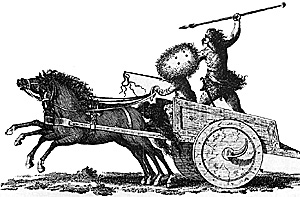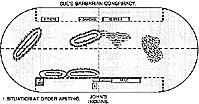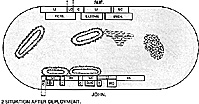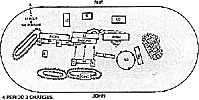 This game was specially laid on at the Kindly Editor's request to illustrate how to go about order writing with Wargames Research Group 5th edition ancient rules. It was played as a genuine game, but because of the delays likely while the furiously scribbling scribe caught up, not as a Society of Ancients competition game.
This game was specially laid on at the Kindly Editor's request to illustrate how to go about order writing with Wargames Research Group 5th edition ancient rules. It was played as a genuine game, but because of the delays likely while the furiously scribbling scribe caught up, not as a Society of Ancients competition game.
Both the players involved normally don't play friendlies, so this was a special concession on their parts. They were my wife Sue in her capacity as leading English Ancient Briton and believer in simple orders and John Westwood who is our most successful Indian player and believer in low cunning, and both fairly well in character.
The reasons they don't often play friendlies are because John hates to waste all that dice telekinesis and Sue's Brigantes, like the Ghurka's kukri, are not unsheathed in jest. This time she borrowed an army, so that was all right.
Both armies were 1,000 pointers taken from the WRG lists. John used his own Indians, Sue a Barbarian Conspiracy army of mixed Saxons, Picts and Irish. John used one elephant mounted general. Sue had a Saxon C-in-C and Pictish and Irish sub-generals responsible for their own contingents. If anyone wants to know why the Saxon was in overall command, this was (a) local chauvinism, and (b), so that the Irish and Picts would have someone else to blame if things went wrong. I must add that the majority of players currently think of Indians as exceptionally tough and Celts as easy meat. Whether that proved to be true you will be able to judge for yourselves.
Choosing Terrain
We started off by choosing terrain in the way specified in the rules. Sue chose 4 for her left, 1 for her right. John chose 6 for his left and 1 for his right. Dicing produced a score of 4 for the eastern half of the table which with Sue's 1 and John's 6 averaged gave 4 terrain pieces. The score for the Western half was 2, which combined with the players' choices gave 2 terrain pieces.
Sue chose a marsh and a wood for the west, which John positioned to constrict her advance. He chose four low ridges. Sue positioned two of these as offensive springboards for charges and John used the remaining pair to screen the eastern half of his deployment from view. The whole process took 2 minutes.
The two sides then compared scouting points, found that neither was outscouted, so drew maps, then deployed those troops that could be seen from anywhere in the opponent's deployment area. This took another seven minutes.
They now started writing their orders based on what could be seen. Sue did not have a lot to go on, except that there could not be any elephants in the west, as they would have been visible over the LC and LI. John could see or guess the positions of the other side's warbands, but knew nothing about any supporting troops. He took just over 10 minutes in order writing, Sue onty 4 minutes, so she was entitled to add 20 paces to each of her first period moves.
 Map 1 shows the situation at this time. Our table is 6 feet long by 3 feet wide. This is plenty for 15 mm, but slightly cramps the deployment areas when playing with 25 mm as we were.
The usual British table size is 6 feet by 4 feet. The two center axis and the deployment areas are shown dotted. Once orders had been written, deployment was completed, producing the situation shown in Map 2.
<>Armies
Map 1 shows the situation at this time. Our table is 6 feet long by 3 feet wide. This is plenty for 15 mm, but slightly cramps the deployment areas when playing with 25 mm as we were.
The usual British table size is 6 feet by 4 feet. The two center axis and the deployment areas are shown dotted. Once orders had been written, deployment was completed, producing the situation shown in Map 2.
<>Armies
Sue had in fact the following troops:
-
1 C in C on foot with 49 Irregular "B" MI armed with heavy throwing weapons.
2 Pictish sub-general in two-horse light chariot escorted by two similar chariots.
3 Irish sub-general on foot with 29 Irregular "C" LMI armed with javelins.
4 Pictish warband of 50 Irregular "C" LMI with long thrusting spears.
5,6 Two units of 21 and 22 Pictish Irregular "C" LI with bow and no shield.
7,8 Two units of 10 Pictish Irregular "C" LC with javelins.
Most of these had Advance and attack orders. The two archer units instead had orders to support the Pictish and Saxon warbands respectively by skirmishing. The two cavalry units were to attack enemy exposing flank or rear, or failing such targets, support the chariots and Irish respectively by attacking. There was one signal, a blast on the war horn indicating All units attack nearest enemy. As is often the case here, she did not use standing orders.
John's army consisted from right to left of the following units:
-
A 10 Irregular "C" LC with bow, unshielded.
B, C 2 units of 10 Regular "C" MC with javelins; 7 Irregular "C" LI with bow and two-handed sword, unshielded.
D: 1 Irregular "B" elephant with two javelin-armed fighting crew.
E, F: 2 units of 20 Regular "C" MI with bow and two-handed sword, unshielded.
G: C-in-C mounted on an elephant and accompanied by two other elephants.
H, I, J: 3 units of 1 two-horse heavy chariot with javelin-armed driver and two archers.
K: 10 Regular "C" HI with bow and two-handed sword, shieldless, with second rank of 10 MI.
L: Another elephant.
The C in C and his bodyguard were of course under Follow me orders. The other elephant units had orders to Advance and attack. The light cavalry were to advance, attack any enemy who were disordered or exposing flank or rear, otherwise skirmish. The infantry again had Advance and attack orders. The chariot and medium cavalry units were each ordered to support a specific infantry unit by attacking. John had one signal, which invoked an attack by any unit with a retiring or disordered target, or one exposing a flank or rear. He also had copious standing orders, which he would rather not have publicized!
However, these had no influence at all on the game, as with the exception of target priorities, they were all overridden by his battlefield orders. The target priorities didn't help either, as believe it or not, he rarely had more than one eligible target at a time.
Period 1
 During period one, both sides moved forward, creating room for the tail ends of some units to get on to the table. The main exception was John's general and his three elephants. I suspect John had not counted on those Pictish archers and would have much preferred not to advance his valuable elephants and chariots into jeopardy.
During period one, both sides moved forward, creating room for the tail ends of some units to get on to the table. The main exception was John's general and his three elephants. I suspect John had not counted on those Pictish archers and would have much preferred not to advance his valuable elephants and chariots into jeopardy.
Unfortunately, with the exception of the boss's lot, their orders left no choice, so while he sneaked up to a howdah-down position just below the ridge crest, everyone else swept forward over the ridge. If Sue's archers had been closer at the time they could have engaged the chariots as they crossed the skyline, but as it was, by the time they came within range, the elephants were practically the only troops exposed to them.
Being behind their own spearmen, except for a few men climbing the inner end of the eastern ridge, all the archers could see were the elephants rising above intervening friends and foes alike. The archers did not object. The elephants emphatically did, but their morale managed to survive "two shooting casualties per figure" immediate reaction tests.
John's return archery had to be spread over the three hostile warbands and did not cause them any great worry. John's general being out of his troops sight, they as well as Sue's had to take first sighting tests. As it happened, everyone in the end decided to obey orders, although John's most eastern chariot threw high enough to raise his blood pressure.
Period 2
 Period two started with a batch of charge declarations, against the Pictish spearmen by a unit each of HI and MI, two chariots and an elephant, and against the supporting LI by MC. Although the Pictish spearmen had attack orders, they managed to get the reaction score down to the option to hold if a charge would disorder them, as being caught while moving
by mounted troops would. The LI shot before evading, were caught and broken, but scored enough hits on the elephant to make it feel very ill indeed.
Period two started with a batch of charge declarations, against the Pictish spearmen by a unit each of HI and MI, two chariots and an elephant, and against the supporting LI by MC. Although the Pictish spearmen had attack orders, they managed to get the reaction score down to the option to hold if a charge would disorder them, as being caught while moving
by mounted troops would. The LI shot before evading, were caught and broken, but scored enough hits on the elephant to make it feel very ill indeed.
After the melee had been ajudicated, it staggered back 20 paces with only 4 of its 20 lives remaining and took no further part in the game. The Picts fought well, but the impact of chariots and the effect of the HI were too much for them and they were forced to recoil.
The Pictish cavalry and chariots tried to keep out of the way of the elephants' disordering distance and to hope for a flank to jump on. The Indian C in C continued to hide, and the rest of the two armies continued closing, the Irish being especially happy in their bog. Map 3 shows the situation as the charges
End of period reaction tests left the Conspiracy forces unscathed, but their eastern flank was now very dodgy. Not only was the light infantry about to be pursued off the table, but the Pictish spears were disordered by their recoil, and it was obviously the Saxons turn next.
Sure enough, an elephant, a chariot and an MI unit declared charges on them as period three opened. As in the previous charges, the Saxons were able by adjusting reaction factors to get an optional hold to avoid being disordered. lust as before, the elephant was almost neutralized by archery. The difference lay in the increased fighting power in the first round of melee of MI with heavy throwing spears compared with LMI with long spears.
The elephant dropped dead on the spot, and only good dice and the intervention of the HI already fighting the Picts prevented the Indians from being pushed back. The Saxons held their ground, but they too were now disordered by failing to bounce off the chariots.
Worse to Come
Worse was to come. The Picts were pushed back a second time and broke, while the Indian MC ad pursued off the table before they could be jumped on and might return in the near future. (As it happens they didn't. John says they never come back in such circumstances, even though regular.) The end of the period tests were much more fraught this time, but the conspiracy still managed to hang together.
 All now depended on the Irish, at which thought all who knew them laughed hysterically. Other people's Irish fight well, but not ours. They have the remarkable record of going into uncontrolled advance in each of their first three games without either contacting the enemy or even throwing a javelin. This time they managed it, throwing two 6s and a 5 in their test to charge next period.
All now depended on the Irish, at which thought all who knew them laughed hysterically. Other people's Irish fight well, but not ours. They have the remarkable record of going into uncontrolled advance in each of their first three games without either contacting the enemy or even throwing a javelin. This time they managed it, throwing two 6s and a 5 in their test to charge next period.
Cynics pointed out that they had already established that the general in their front rank was cautious, so were making a typical grand standing gesture without risk. Certainly the enemy thought so, because not only the LI and MC willing to face them, but the circling LC countercharged as well. This was unwise of the LC, who became the first unit to be pushed back by Barker Irish.
It was later pointed out that our Celtic saint had been brought out to make up the units numbers, and that the LC had a snake for their standard. Of such things are legends made! The other two Indian units had no such disadvantage and pushed the Irish back into their bog.
Elsewhere, the Saxons had held their ground again and recovered as much order as barbarians are entitled to. However, even a rash red haired Pictish queen was having difficulty in getting her chariots to charge, and the Pictish light cavalry were discussing the best route back to Aberdeen. The Indian general was feeling much braver and had come out from behind the hill, ready for the expected victory parade.
Could the Irish Hold?
Could the Irish hold, giving a chance for routers to rally, mounted to recover confidence and archers to finish off the remaining elephants? Are you kidding? The only excuse they needed to go was one casualty per figure next period. Twenty-nine figures were left -- and exactly 29 casualties were received. The remaining Celts decided that if they hurried they could just get a drink in before closing time and departed, leaving the less mobile Saxon MI to make what arrangements they could.
Play was a little slower than usual, averaging just over 30 minutes a period, but that was probably my fault, holding it up to ask questions, make sketches and write it down. Talking it over after, we more or less agreed that Sue would have done better to extend the warbands further and cover the archers more, while John should have put his hills elsewhere. No one suggest starting again!
Back to Table of Contents -- Courier Vol. 1 #2
To Courier List of Issues
To MagWeb Master Magazine List
© Copyright 1979 by The Courier Publishing Company.
This article appears in MagWeb (Magazine Web) on the Internet World Wide Web.
Other military history articles and gaming articles are available at http://www.magweb.com